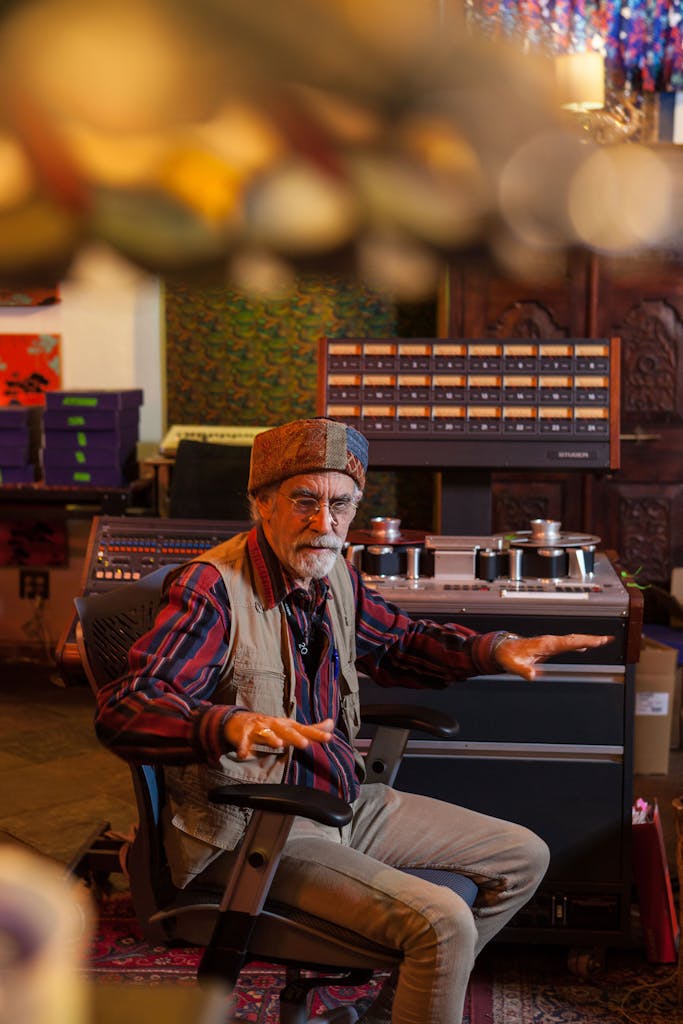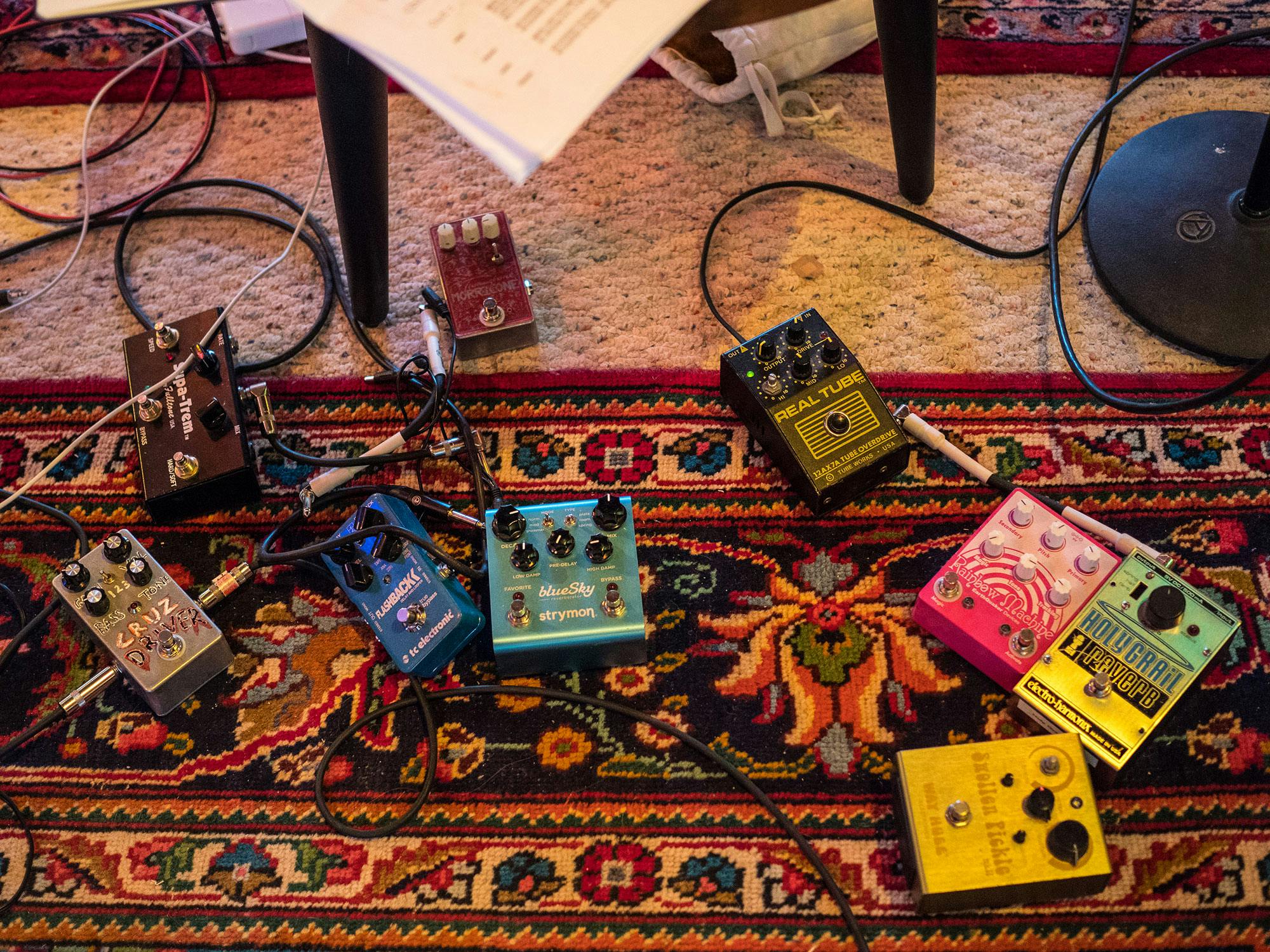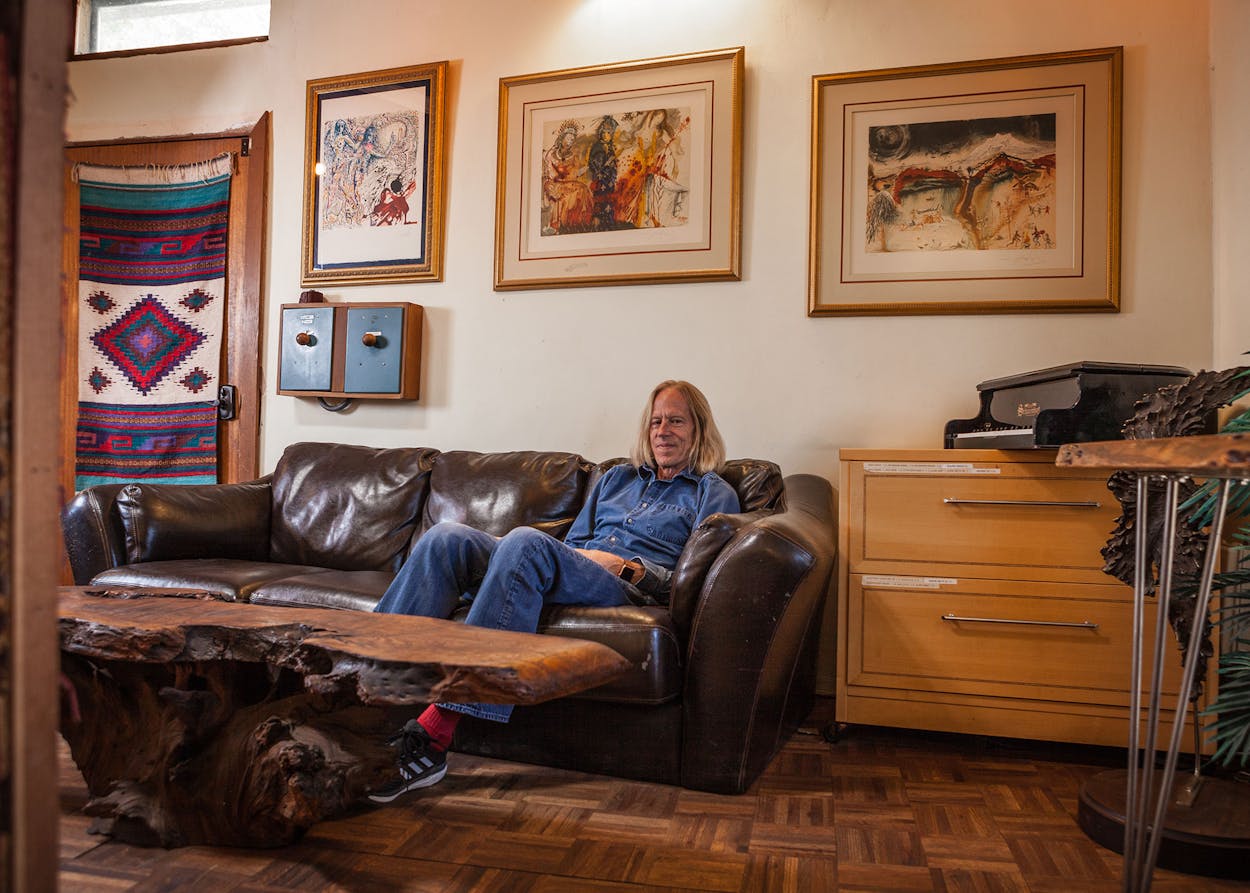For Tony Rancich, it’s about synchronicity. “The definition is: like atmospheres and attitudes tend to gravitate toward each other’s orbits,” he told me one day last February. He motioned toward two of the six stray cats that wander the grounds of the Sonic Ranch, his recording studio in Tornillo, forty miles east of El Paso. “That’s how the cats got here. That’s how you got here. That’s how the artists got here.”
The notion of cosmic coincidence is practically conventional at Sonic Ranch (without prompting, a musician and engineer mentioned how his career had been aided “with some synchronicity” from the studio). So it seems almost natural to Rancich that the place where he grew up would house his unusual recording studio—even if his family’s 3,300-acre operating pecan orchard might seem like an unlikely setting to most. Rancich inherited the property decades ago, after his mother and his maternal grandparents died, and began transforming it into the “world’s largest residential recording studio”: six studios are scattered throughout the compound, which includes a twelve-room 1930s hacienda built by Rancich’s grandfather. Although the acoustic design has earned the studio a national reputation, Sonic Ranch’s true distinction is as a place to encounter the Looking Glass: each door seems to lead to a different dimension.
“Do not adjust your television set,” Rancich said, tucking a few strands of his bobbed white-blond hair behind an ear as he led me into a studio sound room. Spinning around from the console was visiting engineer Rob Fraboni, taking a break from recording the New York roots-rock band Donna the Buffalo. “A friend of mine [who was working on Sonic Ranch acoustic design] called me at one point. He says, ‘I’m building a studio in El Paso,’ and I say, ‘Well, you know. Maybe when I go see Marty Robbins!’ I’m not going to be in El Paso, right?” he said. “So then all these years later, Keith Richards’s nephew, who lives in El Paso, says to me, ‘There’s this great studio in El Paso’—Tornillo, actually. And so I looked at the website and I thought, ‘No way.’ I thought, ‘This is fucking faked.’”

Fraboni, 66, has recorded and engineered records for Bob Dylan, the Rolling Stones, the Band, and Eric Clapton, and owned Shangri-La studios in Malibu for ten years before selling it to producer Rick Rubin. He made it a point to emphasize that he was not easily impressed. “Mr. Pecan here buys guitars that people would put in a Plexiglas box on the wall and he lets musicians play them,” he said, inching closer to maintain maximum eye contact. “I mean, this is fucking unusual! I mean, it’s really unbelievable, actually.” Fraboni went on citing reasons for his appreciation: Sonic Ranch was isolated, it was cheap, and it supplied meals and housing. The place was not a typical studio. Even the constellations seemed distinctive to Fraboni. “I thought the Big Dipper empties out in the winter and fills up in the summer. But this damn place. I don’t know what’s going on here, but the Big Dipper is…” He waved his hands in circles in front of his face.
In the mixing room, Jared Evans, a producer from Oklahoma, worked on an eighties throwback project called Prettyboy. Underscoring his commitment to the era, Evans wore a stonewashed jean jacket, wire-rimmed glasses, and white sneakers. “We are living in the eighties, OK?” he said. “It’s mellow in the eighties.” He cued a soft rock ballad reminiscent of John Waite’s “Missing You.”


Around the time an alto sax broke into the mix, Rancich pointed out the sound panels he had covered with hand-selected fabrics, giving the walls the appearance of a patchwork quilt. “We also have over forty original Salvador Dalí lithographs from Paris, some Joan Mirós, some Chagalls, Picassos, and Matisses,” he said. Not that the décor was pretentious: a visitor is as likely to sit in a 1980s airline seat as an 1800s barber chair.
In one subterranean studio, as a drummer from the Santa Cruz Americana band Devil Makes Three experimented with different bass drum heads, Rancich explained that the dirt surrounding the walls provided a solid sound. “Chinchillas were raised in this room in the forties,” he explained. Surprised, the drummer looked up from his work to make sure he’d heard right.
“These are vintage Roger drums,” Rancich continued, pointing to a kit and the surrounding microphones. “We’ve got a Ludwig kit similar to Ringo’s. These microphones are C-12s from the sixties.”
Rancich touched the instruments as he passed them, sometimes lingering as if he were still in awe that he possessed such rare, beautiful things. “These are Neumann microphones from the fifties. This is a U47 long body chrome top.”
“All these are vintage amplifiers. Here’s a ’62 Showman.”
“This piano is from 1895—this is a real Brazilian rosewood solid piano.”

At one point, he pulled a faded-yellow guitar out of a case. “This is part of our eighty-plus guitar collection. This belonged to Stevie Ray Vaughan.” He strummed it. “Feel that vibration.”
Seconds passed. He waited.
“It’s still vibrating.”
As Rancich wandered from room to room, he explained how he came to start a recording studio in a town whose population of 1,500 mainly supported farms for pecans, cotton, and alfalfa. Gesturing toward a large Arabian-themed abstract mural in his dining room, he said, “When I was probably nine years old, my mom painted this in a day or two.” She, along with his maternal grandparents, died suddenly and within months of each other when he was eleven years old. “It was very tragic,” he continued. “That being said, I have a theory about death. You know they are no longer physically here, but if you don’t shut the door, any great spirit continues. I’ve always felt their presence and it has inspired me.”
Rancich suggested that his mother’s creativity might have rubbed off on him. When he was fifteen years old, he bought a Sony tape recorder and started taping himself playing guitar. Soon afterward, he bought two four-track recorders, which attracted musicians who wanted to use his equipment.
In the years that followed, he acquired a few surrounding properties along with better—and more fabled—gear. El Paso musician Jim Ward, formerly guitarist for At the Drive-In and Sparta, later told me, “When I look in the closet and I see something that I haven’t been playing, I sell it to him…It’s like sending your pet to the farm. Go live your life! And I’ll get a picture like from Old 97’s playing my old Rickenbacker.”

While many bands who’ve recorded at Sonic Ranch are lesser known—or totally unknown—big acts make the trek to Tornillo, including TV On the Radio, Billy Gibbons, Conor Oberst, and the Yeah Yeah Yeahs, along with Mexican acts like Zoé. The musicians tend to stick out in Tornillo. They draw attention when they’re recognized riding Sonic Ranch bicycles through town or, on a lark, wandering into the Family Dollar.
Near the end of the day, as the sun began to set, Rancich rounded out my tour with some of his favorite activities: he drove us a mile or so down to the Rio Grande to look into Mexico, then he circled back to some dunes, where we hiked and looked for Apache pottery fragments. After he found some painted segments, he asked, “Do you want to climb the water tower?”
As he drove through the sand toward a short, rusted water tower, he said, “I tell artists, ‘If you want, there’s a ramp going up to it and there’s a ramp on the back side. Are you all down to jump it?’ Ninety-nine percent of all the artists go, ‘Let’s do it!’ and if there’s any management, they’ll go, ‘No!’”
“So let’s simulate this. If they say ‘yes,’ we crank up the music and here we go!”
He began accelerating and swerving wildly up the bank where the water tower stood, slamming on the brakes just before impact. Doubled over laughing, he stepped out of the car and climbed a short distance to the top of the flat tower, where he could see for miles around: the scrub brush, the sand, the silhouette of the Franklin Mountains in the distance.
“Bands like to lie up here and watch the stars,” he said.
I hear the constellations do strange things.
- More About:
- Music








